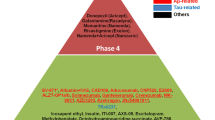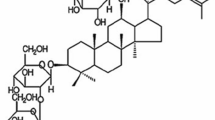Abstract
Alzheimer’s disease is a neurodegenerative disease characterized by the production of β-amyloid proteins and hyperphosphorylation of tau protein. Inflammation and apoptotic severity were highly correlated with earlier age at onset of Alzheimer’s disease and were also associated with cognitive decline. This study aims to examine whether the traditional Chinese medicine ginsennoside Rd could prevent cognitive deficit and take neuroprotective effects in β-amyloid peptide 1–40-induced rat model of Alzheimer’s disease. To produce Alzheimer’s disease animal model, aggregated β-amyloid peptide 1–40 injected into hippocampus bilaterally. Ginsennoside Rd protected their cognitive impairment and improved their memory function by daily intraperitoneal injection for 30 days consecutively. In addition, ginsennoside Rd alleviated the inflammation induced by β-amyloid peptide 1–40. Furthermore, ginsennoside Rd played a role in the down-regulation of caspase-3 proteins and reduced the apoptosis that normally followed β-amyloid peptide 1–40 injection. The results of this study showed that the pretreatment of ginsennoside Rd had neuroprotective effects in β-amyloid peptide 1–40-induced AD model rat.







Similar content being viewed by others
References
Hu SY (1977) A contribution to our knowledge of ginseng. Am J Chin Med (Gard City NY) 5:1–23
Yokozawa T, Satoh A, Cho EJ (2004) Ginsenoside-Rd attenuates oxidative damage related to aging in senescence-accelerated mice. J Pharm Pharmacol 56:107–113
Yokozawa T, Liu ZW, Dong E (1998) A study of ginsenoside-Rd in a renal ischemia-reperfusion model. Nephron 78:201–206
Yokozawa T, Owada S (1999) Effect of ginsenoside-Rd in cephaloridine-induced renal disorder. Nephron 81:200–207
Lopez MV, Cuadrado MP, Ruiz-Poveda OM, Del Fresno AM, Accame ME (2007) Neuroprotective effect of individual ginsenosides on astrocytes primary culture. Biochim Biophys Acta 1770:1308–1316
Tamura T, Cui X, Sakaguchi N, Akashi M (2008) Ginsenoside Rd prevents and rescues rat intestinal epithelial cells from irradiation-induced apoptosis. Food Chem Toxicol 46:3080–3089
Li XY, Liang J, Tang YB, Zhou JG, Guan YY (2010) Ginsenoside Rd prevents glutamate-induced apoptosis in rat cortical neurons. Clin Exp Pharmacol Physiol 37:199–204
Lin WM, Zhang YM, Moldzio R, Rausch WD (2007) Ginsenoside Rd attenuates neuroinflammation of dopaminergic cells in culture. J Neural Transm Suppl 72:105–112
Wu CF, Bi XL, Yang JY, Zhan JY, Dong YX, Wang JH, Wang JM, Zhang R, Li X (2007) Differential effects of ginsenosides on NO and TNF-alpha production by LPS-activated N9 microglia. Int Immunopharmacol 7:313–320
Barber R (2011) Inflammatory signaling in Alzheimer disease and depression. Cleve Clin J Med 78(Suppl 1):S47–S49
Burguillos MA, Deierborg T, Kavanagh E, Persson A, Hajji N, Garcia-Quintanilla A, Cano J, Brundin P, Englund E, Venero JL, Joseph B (2011) Caspase signalling controls microglia activation and neurotoxicity. Nature 472:319–324
Stephan A, Laroche S, Davis S (2001) Generation of aggregated beta-amyloid in the rat hippocampus impairs synaptic transmission and plasticity and causes memory deficits. J Neurosci 21:5703–5714
Yan JJ, Cho JY, Kim HS, Kim KL, Jung JS, Huh SO, Suh HW, Kim YH, Song DK (2001) Protection against beta-amyloid peptide toxicity in vivo with long-term administration of ferulic acid. Br J Pharmacol 133:89–96
Peirson SN, Butler JN, Foster RG (2003) Experimental validation of novel and conventional approaches to qPCR data analysis. Nucleic Acids Res 31:e73
Yan XD, Liu JF, Luo ZP, Ding QX, Mao XG, Yan M, Yang SG, Hu XY, Huang JH, Luo ZJ (2010) Proteomic profiling of proteins in rat spinal cord induced by contusion injury. Neurochem Int 56:971–983
Linkov F, Ferris RL, Yurkovetsky Z, Marrangoni A, Velikokhatnaya L, Gooding W, Nolan B, Winans M, Siegel ER, Lokshin A, Stack BC Jr (2008) Multiplex analysis of cytokines as biomarkers that differentiate benign and malignant thyroid diseases. Proteomics Clin Appl 2:1575–1585
DuPont NC, Wang K, Wadhwa PD, Culhane JF, Nelson EL (2005) Validation and comparison of luminex multiplex cytokine analysis kits with ELISA: determinations of a panel of nine cytokines in clinical sample culture supernatants. J Reprod Immunol 66:175–191
Hissin PJ, Hilf R (1976) A fluorometric method for determination of oxidized and reduced glutathione in tissues. Anal Biochem 74:214–226
Tseng YC, Chen RD, Lucassen M, Schmidt MM, Dringen R (2011) Exploring uncoupling proteins and antioxidant mechanisms under acute cold exposure in brains of fish. PLoS ONE 6:e18180
Roh MI, Murakami Y, Thanos A, Vavvas DG, Miller JW (2011) Edaravone, an ROS scavenger, ameliorates photoreceptor cell death after experimental retinal detachment. Invest Ophthalmol Vis Sci 52:3825–3831
Greenberg BD, Savage MJ, Howland DS, Ali SM, Siedlak SL, Perry G, Siman R, Scott RW (1996) APP transgenesis: approaches toward the development of animal models for Alzheimer disease neuropathology. Neurobiol Aging 17:153–171
Nitta A, Fukuta T, Hasegawa T, Nabeshima T (1997) Continuous infusion of beta-amyloid protein into the rat cerebral ventricle induces learning impairment and neuronal and morphological degeneration. Jpn J Pharmacol 73:51–57
Bons N, Mestre N, Ritchie K, Petter A, Podlisny M, Selkoe D (1994) Identification of amyloid beta protein in the brain of the small, short-lived lemurian primate Microcebus murinus. Neurobiol Aging 15:215–220
Itoh A, Nitta A, Nadai M, Nishimura K, Hirose M, Hasegawa T, Nabeshima T (1996) Dysfunction of cholinergic and dopaminergic neuronal systems in beta-amyloid protein–infused rats. J Neurochem 66:1113–1117
Xuan NT, Shumilina E, Kempe DS, Gulbins E, Lang F (2010) Sphingomyelinase dependent apoptosis of dendritic cells following treatment with amyloid peptides. J Neuroimmunol 219:81–89
Wirths O, Breyhan H, Marcello A, Cotel MC, Bruck W, Bayer TA (2010) Inflammatory changes are tightly associated with neurodegeneration in the brain and spinal cord of the APP/PS1KI mouse model of Alzheimer’s disease. Neurobiol Aging 31:747–757
Hensley K (2010) Neuroinflammation in Alzheimer’s disease: mechanisms, pathologic consequences, and potential for therapeutic manipulation. J Alzheimers Dis 21:1–14
Craft JM, Watterson DM, Van Eldik LJ (2006) Human amyloid beta-induced neuroinflammation is an early event in neurodegeneration. Glia 53:484–490
Akiyama H, Barger S, Barnum S, Bradt B, Bauer J, Cole GM, Cooper NR, Eikelenboom P, Emmerling M, Fiebich BL, Finch CE, Frautschy S, Griffin WS, Hampel H, Hull M, Landreth G, Lue L, Mrak R, Mackenzie IR, McGeer PL, O’Banion MK, Pachter J, Pasinetti G, Plata-Salaman C, Rogers J, Rydel R, Shen Y, Streit W, Strohmeyer R, Tooyoma I, Van Muiswinkel FL, Veerhuis R, Walker D, Webster S, Wegrzyniak B, Wenk G, Wyss-Coray T (2000) Inflammation and Alzheimer’s disease. Neurobiol Aging 21:383–421
Wyss-Coray T (2006) Inflammation in Alzheimer disease: driving force, bystander or beneficial response? Nat Med 12:1005–1015
Wyss-Coray T, Loike JD, Brionne TC, Lu E, Anankov R, Yan F, Silverstein SC, Husemann J (2003) Adult mouse astrocytes degrade amyloid-beta in vitro and in situ. Nat Med 9:453–457
Rossner S, Lange-Dohna C, Zeitschel U, Perez-Polo JR (2005) Alzheimer’s disease beta-secretase BACE1 is not a neuron-specific enzyme. J Neurochem 92:226–234
Sastre M, Klockgether T, Heneka MT (2006) Contribution of inflammatory processes to Alzheimer’s disease: molecular mechanisms. Int J Dev Neurosci 24:167–176
Nagele RG, Wegiel J, Venkataraman V, Imaki H, Wang KC (2004) Contribution of glial cells to the development of amyloid plaques in Alzheimer’s disease. Neurobiol Aging 25:663–674
Folch J, Alvira D, Lopez-Querol M, Tajes M, Sureda FX, Forsby A, Rimbau V, Camins A, Pallas M (2010) Evaluation of transcriptional activity of caspase-3 gene as a marker of acute neurotoxicity in rat cerebellar granular cells. Toxicol In Vitro 24:465–471
Li Z, Jo J, Jia JM, Lo SC, Whitcomb DJ, Jiao S, Cho K, Sheng M (2010) Caspase-3 activation via mitochondria is required for long-term depression and AMPA receptor internalization. Cell 141:859–871
Kang HJ, Yoon WJ, Moon GJ, Kim DY, Sohn S, Kwon HJ, Gwag BJ (2005) Caspase-3-mediated cleavage of PHF-1 tau during apoptosis irrespective of excitotoxicity and oxidative stress: an implication to Alzheimer’s disease. Neurobiol Dis 18:450–458
Yan X, Xiao R, Dou Y, Wang S, Qiao Z, Qiao J (2000) Carbachol blocks beta-amyloid fragment 31–35-induced apoptosis in cultured cortical neurons. Brain Res Bull 51:465–470
Acknowledgments
This work was supported by the National Natural Science Foundation of China (No. 81073094). We thank Dr. Dongyun Feng for the technique support in Western blot.
Conflict of interest
The authors declare that they have no conflict of interest.
Author information
Authors and Affiliations
Corresponding author
Additional information
Juanfang Liu, Xiaodong Yan and Ling Li contributed equally to this work.
Rights and permissions
About this article
Cite this article
Liu, J., Yan, X., Li, L. et al. Ginsennoside Rd Attenuates Cognitive Dysfunction in a Rat Model of Alzheimer’s Disease. Neurochem Res 37, 2738–2747 (2012). https://doi.org/10.1007/s11064-012-0866-2
Received:
Revised:
Accepted:
Published:
Issue Date:
DOI: https://doi.org/10.1007/s11064-012-0866-2




